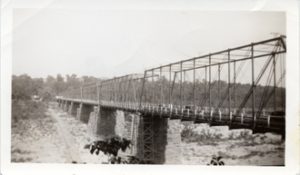
The first bridge to cross the Potomac in the Washington area was constructed in 1797 when Georgetown merchants built the “Falls Bridge” at the “Little Falls.”
The bridge was built to replace ferry service and was primarily used to drive cattle across to the Georgetown auction markets after the cattle had drunk heavily at Pimmit Run.
There have been eight bridges built on this site. The original one was a covered wooden structure that collapsed in 1804, and the second was destroyed by floods after only 6 months. In 1810, a third bridge was constructed that was truly a “Chain Bridge,” the name by which all subsequent bridges have been known. Two chains were made from four-foot links of wrought iron and suspended from massive stone towers at either shore. The bridge itself was 136 feet long and 15 feet wide.
This was a toll bridge which reported $9,000 in collected tolls in 1810. Tolls, thought to be high, were:
- Four Horse Carriage: 1 ½ dollars
- Two Horse Carriage: 1 dollar
- Four Horse Wagon: 62 ½ cents
- Two Horse Wagon: 37 ½ cents
- Gig: 36 ½ cents
- Man: 6 ½ cents
It was a relatively low bridge, and floods were a continuing problem. The third, fourth, and fifth structures were all swept away by high water.
The present Chain Bridge, a simple continuous steel girder structure, was built in 1939 with a vertical clearance between the bridge and the river of 45 feet. Nevertheless, in times of severe flooding, such as that experienced during Hurricane Agnes in 1972, the water level was so high that it became within a few feet of the bridge’s floor.
Do you remember Chain Bridge during the 1972 flooding?
I absolutely remember Chain Bridge during Agnes–I crossed over it on the way to D.C.–the bridge was not closed—the water was only a few feet below! FREAKY! I have never seen the water close to that high since!
I was at summer camp in Maryland when Agnes struck. It just poured down rain. We got back from camp early as soon as the storm let up and was safe to travel. When we returned to Arlington, everything was wet! I looked in our backyard and commented on the pond we now had. My dad said, “If you think that’s something, get in the truck and I’ll show you something really amazing!” that’s when he drove us down to Chain Bridge. Quite a few people were there. The was flood water on both sides of the bridge and all we could see was the middle of the bridge sticking out of the water. it was days before anyone could cross it.
I remember Agnes well as I got a call from my dad in the middle of the night telling me to get to the boathouse (Fletcher’s) as soon as possible to help save what little equipment we could
It took me awhile to get there from my house in Mclean Va AS lots of the roads were flooded and closed
Crossing Chain bridge I could hear the river running like I never hear it
when I got to canal Road and Arizona Ave, Canal Road was blocked with a policeman turning cars up Arizona towards MacArthur Blvd which I did making a right turn on MacArthur than a right on Resvior Rd. towards Canal Road only to be stopped by another policeman who know me and allowed me to get to the boathouse
Crossing Canal to the driveway into the boathouse not thinking the tunnel was under water i was in for my first shock seeing only water where the opening of the tunnel under the canal should of been
Backing back up into the upper parking lot I pulled the ferryboat a cross the canal
When I got into the ferry boat I noticed the canal had a strong current in it
Running down the hill I saw that the river was higher than I had ever seen it in my life and I have been on the river since the mid 1940’s as a young child
It was dark but dad and I could tell that most if not all are boats, canoes, and docks were gone
At first light there were only a short string of rowboats still in a line with water up to there gunnels still there with what looked like a river running between the boats and where we were standing on shore
After a great deal of thought it was decided to swim
out with a pair of oars and climb into a boat and bail it out to have a boat to work out of
It took a few hours to bail all the water out of the
16 boats that were left from the 80 we had
Than we rowed all the boats to shore towing one at a time across the swift current
All the time the river kept rising causing us to to think about moving our equipment out of the rental building and the other building where we housed close to 100 rental bikes and other equipment
–MORE TO COME IF YOU WANT IT———
Joe,
Please post more memories! Very exciting hearing your first hand account of Agnes! I’ve been going to Fletcher’s Boathouse since the 1970’s and still enjoy it.
HISTORY HAS A WAY OF GETTING LOST IF NOT POSTED
GREAT JOB
MY FAMILY MARRIED ANNIE DONALDSON FROM ARLINGTON VA
CORRECTION-_CORRECTION -CORRECTION
ANNIE FLETCHER SHOULD OF BEEN ERMA IRENE DONALDSON MARRIED MY GRANDFATHER-JOSEPH CLEVELAND FLETCHER
ANNIE FRIZZELL MARRIED MY GREAT GRANDFATHER
ALL ARE BURIED AT WALKER’S CHAPEL ARLINGTON